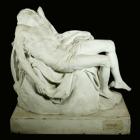The legacy of the Museo d'Arte Antica (Museum of Ancient Art) comprises mainly stone artefacts: statues, architectural fragments and funerary and celebratory monuments. With the exception of some rare examples, the entire collection originates from buildings and structures from within the medieval walls of Milan.
Statues and sculptures
The votive statues from the city walls, the majestic remains from the Duomo and the monasteries, the emblems and portals from noble palazzi testify to a period of history that spans from the 5th century to the height of the Renaissance. The artefacts are in large part the work of master craftsmen from Lombardy, joined by artists from other areas, in particular from Tuscany, who left a lasting mark on the city. These characteristics together with the exceptional quality of a series of masterpieces make the Museum of Antique Art unique in the Italian panorama.
Headstones and inscriptions
Among the institute's possessions, the headstones and inscriptions, which cover a period from the 5th to the 20th century, hold particular significance and function as an important historical record for the city. These include the headstone of the Consul dated 1178 and the Ausonio headstone sculpted in the 16th century. An original itinerary through some of the headstones was commissioned by notable Lombard families and has been mounted in the honour corridor of Palazzo Marino (viewing upon request).
Plaster casts
The museum also houses another singular collection, that of the plaster casts, which experienced an unexpected revival in the second half of the 19th century. Among the collection, counting some one hundred pieces, are copies of sculptures by Agostino Busti. These sculptures, commissioned in 1872 of Piero Pierotti, an artistic virtuoso, are of particular interest (viewing upon request).
Terracottas
A substantial series of decorative tiles and busts, numbering over one thousand varieties, make up the terracotta section, (viewing upon request). The terracotta and stone exhibits often originate from the same buildings, as is the case of the famous Busts of the Emperor (crafted in clay and originally polychrome) and the majestic portal sculpted from large blocks of Candoglia marble, all of which came from Palazzo del Banco Mediceo.








